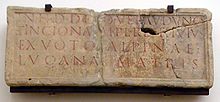Veraudunus
- Veraudunus
-

Une inscription votive de Widdebierg au Luxembourg.
Veraudunus est le nom d'un dieu celtique connu seulement à partir de deux inscriptions votives trouvées au Luxembourg. Une de ces inscriptions suggère que Veraudunus peut avoir été un épithète du dieu Trévires, Lenus Mars. Dans les deux inscriptions, Veraudunus est invoqué avec Inciona qui est probablement sa femme. En gaulois *vero-dunon signifie la grande forteresse.
Bibliographie
- Dictionary of Celtic Myth and Legend. Miranda Green. Thames and Hudson Ltd. London. 1997 (en)
- W. Van Andringa, La religion en Gaule romaine, Ed. Errance, Paris, 2002
- M.-T. Raepsaet-Charlier, Les cultores de Mars en Gaule Belgique, in Mars en Occident, PUR, 2006
- Xavier Delamarre, Noms de personnes celtiques dans l'épigraphie classique, Ed. Errance, Paris, 2007
- L'arbre celtique
Wikimedia Foundation.
2010.
Contenu soumis à la licence CC-BY-SA. Source : Article Veraudunus de Wikipédia en français (auteurs)
Regardez d'autres dictionnaires:
Veraudunus — is the name of a Celtic god known only from two votive inscriptions found in Luxembourg. One of these inscriptions suggests that ‘Veraudunus’ may have been an epithet of the important Treveran god Lenus Mars. In both inscriptions, Veraudunus is… … Wikipedia
Veraudunus — Weiheinschrift auf Sandstein an Veraudunus und Inciona vom Widdenberg, Luxemburg. Veraudunus war ein keltischer Gott aus dem Gebiet der Treverer. Er ist auf zwei Inschriften vom Widdenberg in Luxemburg bezeugt, auf denen er mit Inciona genannt… … Deutsch Wikipedia
Inciona — Weiheinschrift auf Sandstein an Veraudunus und Inciona vom Widdenberg, Luxemburg. Inciona war eine keltische Göttin aus dem Gebiet der Treverer. Vermutlich war sie eine Lokalgottheit des Widdenberges in Luxemburg, wo beide Inschriften gefunden… … Deutsch Wikipedia
Inciona — is a little known Celtic goddess of the Treveran region. Her name is recorded as one of a pair of deities on two votive inscriptions from Luxembourg. On the large stone slab from Mensdorf on the Widdebierg, pictured at right, she is invoked along … Wikipedia
Cernunnos — The Cernunnos type antlered figure on the Gundestrup Cauldron. Cernunnos is the conventional name given in Celtic studies to depictions of the horned god of Celtic polytheism. The name itself is only attested once, on the 1st century Pillar… … Wikipedia
Dis Pater — Dis Pater, or Dispater was a Roman god of the underworld, later subsumed by Pluto or Hades. Originally a chthonic god of riches, fertile agricultural land, and underground mineral wealth, he was later commonly equated with the Roman deities Pluto … Wikipedia
Epona — This article is about the goddess. For the character, see Epona (The Legend of Zelda). Epona, 3rd c. AD, from Freyming (Moselle), France (Musée Lorrain, Nancy) In Gallo Roman religion, Epona was a protector of horses, donkeys, and mules. She was… … Wikipedia
Ancamna — In Gallo Roman religion, Ancamna was a water goddess worshipped particularly in the valley of the Moselle River. She was commemorated at Trier as the consort of Mars Lenus, and at Möhn as the consort of Mars Smertulitanos.Nicole Jufer Thierry… … Wikipedia
Artio — The goddess Artio as depicted in the Muri statuette group, presumably in bear and in human form. Artio (Dea Artio in the Gallo Roman religion) was a Celtic bear goddess. Evidence of her worship has notably been found at Bern (Switzerland) whose… … Wikipedia
Arvernus — In Gallo Roman religion, Arvernus was an epithet of the Gaulish Mercury. Although the name refers to the Arverni, in whose territory Mercury had at important sanctuary at the Puy de Dôme, all of the inscriptions to Mercury Arvernus are found… … Wikipedia

